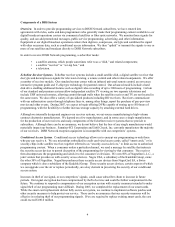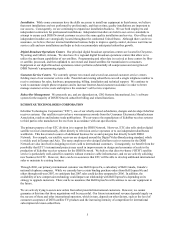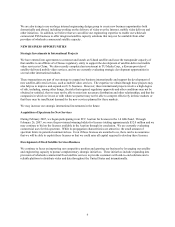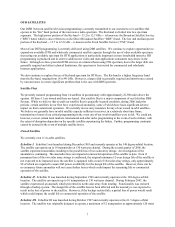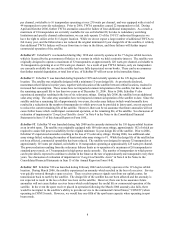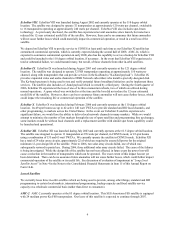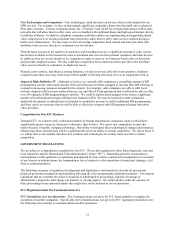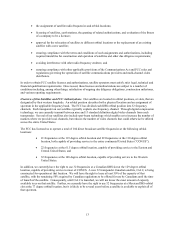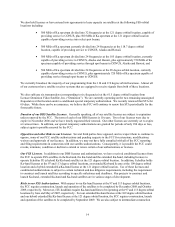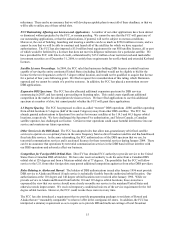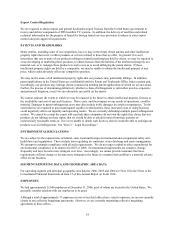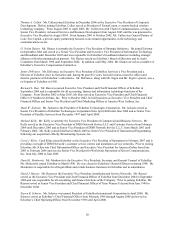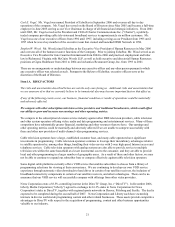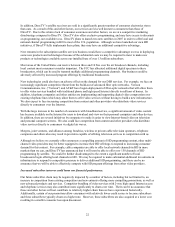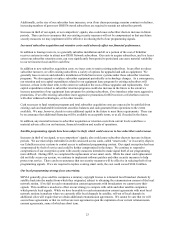Dish Network 2005 Annual Report Download - page 23
Download and view the complete annual report
Please find page 23 of the 2005 Dish Network annual report below. You can navigate through the pages in the report by either clicking on the pages listed below, or by using the keyword search tool below to find specific information within the annual report.13
• the assignment of satellite radio frequencies and orbital locations;
• licensing of satellites, earth stations, the granting of related authorizations, and evaluation of the fitness
of a company to be a licensee;
• approval for the relocation of satellites to different orbital locations or the replacement of an existing
satellite with a new satellite;
• ensuring compliance with the terms and conditions of such assignments and authorizations, including
required timetables for construction and operation of satellites and other due diligence requirements;
• avoiding interference with other radio frequency emitters; and
• ensuring compliance with other applicable provisions of the Communications Act and FCC rules and
regulations governing the operations of satellite communications providers and multi-channel video
distributors.
In order to obtain FCC satellite licenses and authorizations, satellite operators must satisfy strict legal, technical and
financial qualification requirements. Once issued, these licenses and authorizations are subject to a number of
conditions including, among other things, satisfaction of ongoing due diligence obligations, construction milestones,
and various reporting requirements.
Overview of Our Satellites and FCC Authorizations. Our satellites are located in orbital positions, or slots, that are
designated by their western longitude. An orbital position describes both a physical location and an assignment of
spectrum in the applicable frequency band. The FCC has divided each DBS orbital position into 32 frequency
channels. Each transponder on our satellites typically exploits one frequency channel. Through digital compression
technology, we can currently transmit between nine and 13 standard definition digital video channels from each
transponder. Several of our satellites also include spot-beam technology which enables us to increase the number of
markets where we provide local channels, but reduces the number of video channels that could otherwise be offered
across the entire United States.
The FCC has licensed us to operate a total of 104 direct broadcast satellite frequencies at the following orbital
locations:
• 21 frequencies at the 119 degree orbital location and 29 frequencies at the 110 degree orbital
location, both capable of providing service to the entire continental United States (“CONUS”);
• 22 frequencies at the 61.5 degree orbital location, capable of providing service to the Eastern and
Central United States; and
• 32 frequencies at the 148 degree orbital location, capable of providing service to the Western
United States.
In addition, we currently have the right to use 32 frequencies at a Canadian DBS slot at the 129 degree orbital
location, capable of providing service to most of CONUS. A new 32 transponder Canadian satellite, Ciel 2, is being
constructed for operation at that location. We will have the right to lease at least 50% of the capacity of that
satellite, with the remaining 50% required by Canadian regulations to be offered for use by Canadians until the time
of launch of the satellite. Consequently, until Ciel 2 is launched, we will not know the exact amount of capacity
available to us on that satellite. Further, we currently have the right to use 32 frequencies at a Mexican DBS orbital
slot at the 77 degree orbital location, but it is likely to be several years before a satellite is available to exploit all of
that spectrum.



